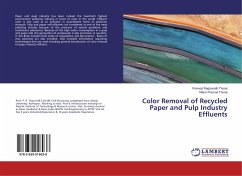This unique book starts with a short historical overview of the development of the theories and applications of industrial color physics. The three dominant factors producing color - light source, color sample, and observer - are described in detail. The standardized color spaces are shown and related color values are applied to characteristic color qualities of absorption as well as of effect colorants. The fundamentals of spectrometric and colorimetric measuring techniques together with specific applications are described. Theoretical models for radiative transfer in transparent, translucent, and opaque layers are detailed; the two, three, and multi-flux approximations are presented for the first time in a coherent formalism. These methods constitute the fundamentals not only for the important classical methods, but also modern methods of recipe prediction applicable to all known colorants.
The work describes in detail the fundamentals as well as the latest developments in research, in particular to be able to work extensively in the far-reaching fields of industrial color physics.
Colors arise only in the brain, normally originating from electromagnetic waves from the outside world. This book is based on courses given by the author in the Department of Colors, Paints and Plastics at the University of Applied Sciences in Stuttgart and continued at the University of Applied Sciences in Esslingen, Germany. The development of color physics in industry began in the middle of the 19th century with the large-scale manufacturing of natural colors. Since that time, a great variety of new, especially synthetic, colorants have been produced in order to meet increasing demands for non-self-luminous colors with regard to color applications. The rapid progress in color physics and accompanying applications over the last three decades are the reasons for this work. Here, the fundamentals of color physics are outlined and the most important recent developments and applications in the color industry are discussed. 1 In comparison to the ?rst German edition, all chapters ofthe book have been revised and expanded with regard to effect pigments. After the introd- tory chapter, the optical fundamentals of absorbing and effect colorants are discussed. The exceptional spectral and colorimetric properties of effect p- ments are detailed in combination with further characterizing parameters. Color spaces are presented as well as the ef?ciency of recent color difference f- mulas. In addition to the normal spectral measuring methods for absorbing colorants, modi?ed procedures for effect colorations are outlined.
The work describes in detail the fundamentals as well as the latest developments in research, in particular to be able to work extensively in the far-reaching fields of industrial color physics.
Colors arise only in the brain, normally originating from electromagnetic waves from the outside world. This book is based on courses given by the author in the Department of Colors, Paints and Plastics at the University of Applied Sciences in Stuttgart and continued at the University of Applied Sciences in Esslingen, Germany. The development of color physics in industry began in the middle of the 19th century with the large-scale manufacturing of natural colors. Since that time, a great variety of new, especially synthetic, colorants have been produced in order to meet increasing demands for non-self-luminous colors with regard to color applications. The rapid progress in color physics and accompanying applications over the last three decades are the reasons for this work. Here, the fundamentals of color physics are outlined and the most important recent developments and applications in the color industry are discussed. 1 In comparison to the ?rst German edition, all chapters ofthe book have been revised and expanded with regard to effect pigments. After the introd- tory chapter, the optical fundamentals of absorbing and effect colorants are discussed. The exceptional spectral and colorimetric properties of effect p- ments are detailed in combination with further characterizing parameters. Color spaces are presented as well as the ef?ciency of recent color difference f- mulas. In addition to the normal spectral measuring methods for absorbing colorants, modi?ed procedures for effect colorations are outlined.







